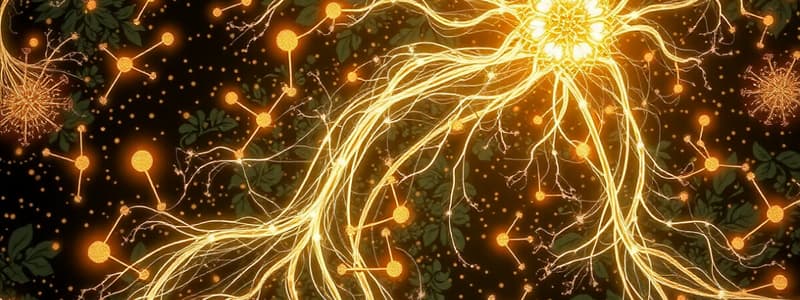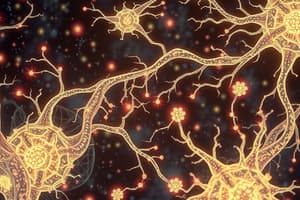Podcast
Questions and Answers
What is the primary role of glial cells in the nervous system?
What is the primary role of glial cells in the nervous system?
- Transmit information to other neurons
- Support and maintain neuronal health (correct)
- Regulate blood flow to neurons
- Protect the nervous system from infections
Which of the following cells are types of glial cells?
Which of the following cells are types of glial cells?
- Erythrocytes
- Myocytes
- Astrocytes (correct)
- Oligodendrocytes (correct)
What is the function of the blood-brain barrier?
What is the function of the blood-brain barrier?
- Transport neurotransmitters across synapses
- Facilitate communication between neurons
- Keep most chemicals and pathogens out of the brain (correct)
- Enhance the replication of neurons
Why is the blood-brain barrier essential for brain health?
Why is the blood-brain barrier essential for brain health?
How do small uncharged molecules cross the blood-brain barrier?
How do small uncharged molecules cross the blood-brain barrier?
What occurs when the endothelial cells of the blood-brain barrier shrink?
What occurs when the endothelial cells of the blood-brain barrier shrink?
What is the typical resting membrane potential of a neuron?
What is the typical resting membrane potential of a neuron?
What maintains the resting potential in a neuron?
What maintains the resting potential in a neuron?
Which mechanism does the sodium-potassium pump use to function?
Which mechanism does the sodium-potassium pump use to function?
During the resting potential, which channels primarily restrict potassium from crossing the membrane?
During the resting potential, which channels primarily restrict potassium from crossing the membrane?
What happens when a virus enters the nervous system?
What happens when a virus enters the nervous system?
What occurs during hyperpolarization of an axon?
What occurs during hyperpolarization of an axon?
What happens if the threshold for an action potential is not met?
What happens if the threshold for an action potential is not met?
What is the threshold of excitation?
What is the threshold of excitation?
Why is the resting potential significant for neurons?
Why is the resting potential significant for neurons?
What regulates the opening of sodium and potassium channels during an action potential?
What regulates the opening of sodium and potassium channels during an action potential?
Which phase of the action potential involves the closing of sodium channels?
Which phase of the action potential involves the closing of sodium channels?
Which ions are primarily affected by the sodium-potassium pump?
Which ions are primarily affected by the sodium-potassium pump?
What happens to the internal charge of an axon during depolarization?
What happens to the internal charge of an axon during depolarization?
What occurs during the relative refractory period?
What occurs during the relative refractory period?
What role do local anesthetic drugs have in relation to action potentials?
What role do local anesthetic drugs have in relation to action potentials?
Where does the action potential begin in a neuron?
Where does the action potential begin in a neuron?
What causes hyperpolarization during an action potential?
What causes hyperpolarization during an action potential?
What is the percentage of sodium ions that cross the membrane during an action potential?
What is the percentage of sodium ions that cross the membrane during an action potential?
Flashcards
Glia cells function
Glia cells function
Support and maintain neurons, but do not transmit information.
Blood-Brain Barrier function
Blood-Brain Barrier function
Keeps harmful substances out of the brain.
Blood-Brain Barrier mechanism
Blood-Brain Barrier mechanism
Tightly joined endothelial cells form a barrier, limiting substance passage.
Resting potential of a neuron
Resting potential of a neuron
Signup and view all the flashcards
Endothelial cells in the brain
Endothelial cells in the brain
Signup and view all the flashcards
Blood-Brain Barrier purpose
Blood-Brain Barrier purpose
Signup and view all the flashcards
Neuron vs. Glia
Neuron vs. Glia
Signup and view all the flashcards
Blood-Brain barrier challenge in medicine
Blood-Brain barrier challenge in medicine
Signup and view all the flashcards
Resting Potential
Resting Potential
Signup and view all the flashcards
Sodium-Potassium Pump
Sodium-Potassium Pump
Signup and view all the flashcards
Action Potential
Action Potential
Signup and view all the flashcards
Depolarization
Depolarization
Signup and view all the flashcards
Hyperpolarization
Hyperpolarization
Signup and view all the flashcards
Threshold of Excitation
Threshold of Excitation
Signup and view all the flashcards
Resting Membrane Potential
Resting Membrane Potential
Signup and view all the flashcards
Selectively Permeable Membrane
Selectively Permeable Membrane
Signup and view all the flashcards
All-or-None Law
All-or-None Law
Signup and view all the flashcards
Action Potential Threshold
Action Potential Threshold
Signup and view all the flashcards
Voltage-Gated Channels
Voltage-Gated Channels
Signup and view all the flashcards
Absolute Refractory Period
Absolute Refractory Period
Signup and view all the flashcards
Axon Hillock
Axon Hillock
Signup and view all the flashcards
Study Notes
Resting Potential
- Neurons maintain a resting electrical gradient, slightly more negative inside than outside.
- This difference is the resting potential, typically -70 millivolts (mV).
- Ion channels and pumps control ion movement across the membrane.
- Sodium-potassium pump actively transports 3 sodium ions out and 2 potassium ions in.
- This maintains a higher concentration of sodium outside the cell and potassium inside.
- Electrical and concentration gradients affect ion movement.
- The electrical gradient attracts positively charged sodium ions into the negatively charged cell.
- The concentration gradient pushes sodium ions into the cell as they are more concentrated outside.
- Potassium faces counteracting forces; the electrical gradient pulls it in, while the concentration gradient pushes it out.
Nerve Impulse - Action Potential
- Action potentials are messages sent by axons.
- They are rapid changes in membrane voltage.
- Hyperpolarization occurs when the negative charge inside the axon increases (e.g., -70 mV becomes -80 mV).
- Depolarization occurs when the negative charge inside the axon decreases, closer to zero (e.g., -70 mV becomes -55 mV).
- The threshold of excitation is the depolarization level needed for an action potential to occur.
- Action potentials follow the all-or-none law, their amplitude and velocity are independent of the stimulus intensity.
Glial Cells
- Glia (neuroglia), are the other major components of the nervous system.
- They don't transmit signals like neurons.
- They are smaller and slightly more numerous than neurons.
- There are several types of glia cells with different functions.
- Astrocytes, oligodendrocytes, microglia, radial glia, and Schwann cell.
Blood-Brain Barrier
- The Blood-Brain Barrier (BBB) prevents most chemicals from entering the brain.
- This is because the brain doesn't have an immune system.
- It protects the brain from harmful substances and viruses by forming a wall.
- Endothelial cells form tight junctions in brain capillaries, creating a barrier.
- Small uncharged molecules (like oxygen, carbon dioxide) and lipid-soluble molecules can passively cross.
- Active transport systems move necessary chemicals across the barrier (e.g., glucose).
- For example, in Alzheimer's disease, the lining of brain blood vessels shrinks, allowing harmful substances to enter.
Studying That Suits You
Use AI to generate personalized quizzes and flashcards to suit your learning preferences.




